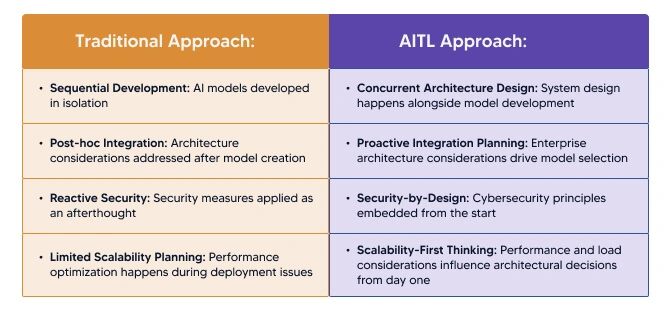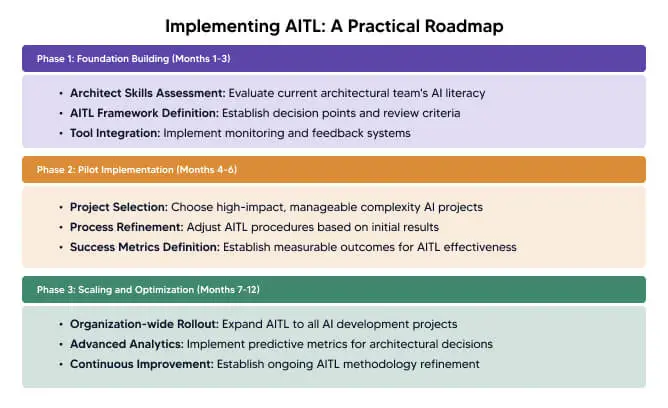Other recent blogs
Let's talk
Reach out, we'd love to hear from you!
In an era where AI promises to revolutionize software development, the most successful organizations are discovering that human expertise hasn't become obsolete—it has become more critical than ever. The tech industry is experiencing what many call the "AI engineering paradox." While AI tools can generate functional code faster than ever before, McKinsey emphasizes the importance of keeping "a human in the loop" and avoiding using generative AI models for critical decisions involving significant resources or human welfare. This paradox reveals a fundamental truth: automation without human oversight creates dangerous blind spots that can compromise entire software ecosystems.
Consider the recent surge in AI adoption: 65% of organizations are now regularly using generative AI in at least one business function, up from a third last year. However, Gartner predicts that over 40% of agentic AI projects will be canceled by the end of 2027, due to escalating costs, unclear business value or inadequate risk controls. This contrast between enthusiasm and execution failure points to a critical gap in how we approach AI-driven development.
Introducing the Architect in the Loop (AITL): A strategic evolution
The Architect in the Loop (AITL) represents a specialized application of Human-in-the-Loop (HITL) methodology that strategically positions software architects at critical junctures of AI/ML development lifecycles. Unlike traditional HITL approaches that focus on data labeling or output validation, AITL emphasizes architectural decision-making at the system level, with particular focus on scalability, design patterns, and security integration.
The fundamental premise of AITL is simple yet powerful: The shift to AI hasn't removed the need for human architectural oversight—it has moved it upstream. But, how AITL differs from Traditional AI Engineering approaches. Well, Traditional AI engineering often follows a linear path:

This approach treats AI models as isolated components, leading to what industry experts call "AI islands"—functional but disconnected systems that struggle to integrate with existing enterprise architecture.
AITL introduces a fundamentally different paradigm by embedding architectural decision-making throughout the AI lifecycle:

Traditional AI development follows a linear "build first, integrate later" approach where models are created independently, then forced into existing systems with security and performance as afterthoughts. AITL flips this by making architects active collaborators from day one. Instead of retrofitting AI into systems, architects guide model selection based on enterprise needs, embed security from the start, and design for scale upfront—preventing costly rework and technical debt.
The critical need for architects in the AI Lifecycle

1. The code quality conundrum
AI-generated code often suffers from what we might call "functional mediocrity syndrome." While the code works, it frequently lacks the architectural sophistication required for enterprise-grade applications. Research shows that AI models excel at producing syntactically correct code but struggle with:
- Context awareness: Understanding broader system implications
- Scalability patterns: Implementing proven architectural patterns for growth
- Compliance adherence: Following internal coding standards and regulatory requirements
- Cross-system integration: Designing for interoperability with existing systems
2. The technical debt multiplication factor
The rapid accumulation of technical debt exacerbates development challenges, hampering engineering velocity, limiting application scalability, and impacting resiliency, with Gartner estimating that by 2028, leaders using structured methods for managing infrastructure technical debt will report 50% fewer obsolete systems.
When AI models are developed without architectural oversight, they often become what we term "intelligent black boxes"—sophisticated algorithms wrapped in poor system design. This creates a multiplication effect for technical debt because:
- Architectural inconsistency: Each AI component follows different design patterns
- Integration complexity: Connecting AI components requires extensive custom code
- Maintenance overhead: Updating one component can break multiple dependencies
- Performance unpredictability: System behavior becomes difficult to optimize or predict
3. Security architecture integration
AI components face unique security challenges, including adversarial attacks, data poisoning, and model extraction threats that traditional security measures don't address. Architects design security-by-design frameworks that embed cybersecurity principles into AI deployment pipelines from inception. They conduct AI-specific threat modeling, implement secure model serving architectures, design protected data pipelines, and create incident response plans for AI-specific vulnerabilities. This proactive security integration prevents costly retrofitting and ensures AI systems meet enterprise security standards and regulatory compliance requirements.
4. Scalability and performance optimization
AI components must integrate seamlessly with enterprise infrastructure while handling varying computational loads and data volumes. Architects analyze performance characteristics within broader system contexts, planning for computational scaling, data volume growth, feature complexity evolution, and service integration expansion. They design load balancing strategies, implement proper caching mechanisms, and establish monitoring frameworks that predict and prevent performance bottlenecks. This architectural foresight ensures AI systems can scale efficiently without requiring fundamental redesigns as business demands grow.
5. Cross-system integration strategy
Modern enterprise AI doesn't exist in isolation but must integrate with legacy systems, established data flows, and existing operational procedures. Architects design integration strategies that account for legacy system dependencies, establish consistent API patterns, define cross-system communication protocols, and create error handling mechanisms. They understand organizational constraints, team capabilities, and operational processes that affect system design decisions. This integration expertise ensures AI components enhance rather than disrupt existing business processes while maintaining system reliability and operational continuity.
The five critical benefits of Architect in the Loop

1. Enhanced accuracy through contextual intelligence
AITL addresses tasks that are too complex for AI alone by providing contextual intelligence that AI models lack. This is essential in sectors where mistakes carry severe consequences. In finance, for example, an AI model might optimize for transaction speed but fail to consider regulatory compliance requirements that could result in millions in fines. A major financial services firm avoided a $50M regulatory penalty by implementing AITL practices that caught AI-generated trading algorithms that would have violated emerging market manipulation rules.
2. Proactive bias prevention and trust building
By embedding architects during data preparation and model validation phases, AITL enables early detection of data bias before it becomes systemic. This is particularly crucial in sectors like legal services, where algorithmic bias can have life-altering consequences. The AITL bias detection framework primarily comprises of:
- Data architecture review: Architects analyze data sources for representation gaps
- Model selection oversight: Ensuring chosen algorithms align with fairness requirements
- Validation framework design: Creating comprehensive testing scenarios for bias detection
- Feedback loop architecture: Designing systems that can adapt when bias is detected in production
3. Security-first AI integration
AI-enhanced malicious attacks have ascended to the top of Gartner's emerging risk rankings in 2024, highlighting the critical need for security-conscious AI development. AITL addresses this by bringing cybersecurity best practices directly into model deployment pipelines. Companies must keep an eye on below-mentioned AITL security Integration points:
- Threat modeling: Architects conduct AI-specific threat assessments
- Secure model serving: Designing deployment architectures that prevent model extraction
- Data pipeline security: Ensuring training and inference data remains protected
- Adversarial attack resilience: Building defenses against data poisoning and adversarial inputs
4. Scalability-driven architecture design
AI components are not isolated entities but integrated elements within broader security and data infrastructure. Architects analyze performance bottlenecks and plan for load balancing to ensure AI solutions can scale efficiently on the AITL Scalability matrix, which rests peacefully on:
- Computational scaling: Planning for model inference load growth
- Data volume scaling: Designing systems that handle exponential data growth
- Feature complexity scaling: Architecting for evolving model capabilities
- Integration scaling: Ensuring new AI services can be added without system redesign
5. Risk mitigation through architectural oversight
By increasing architectural oversight, organizations can systematically de-risk the limitations of AI-generated code. While AI agents can dynamically adjust actions and self-correct based on reasoning, critical operations such as database modifications or accessing sensitive information require human architectural judgment.
How does human-in-the-loop (HITL) in AI work? Revealing a phase-by-phase roadmap
Phase 1: Data collection and preparation
The first phase of HITL involves human experts in curating and preparing training data. Human annotators label datasets, validate data quality, and identify potential biases or gaps in the training material. Domain experts review the data to ensure it accurately represents real-world scenarios and use cases. This phase is critical because the quality of human input directly impacts the AI model's performance and reliability.
During this phase, humans establish data standards, create annotation guidelines, and perform quality control checks. They also identify edge cases and corner scenarios that the AI system should be prepared to handle. The human oversight ensures that the training data is comprehensive, unbiased, and aligned with the AI system's intended application.
Phase 2: Model training and validation
In the training phase, humans work alongside AI systems to iteratively improve model performance. Human experts monitor training progress, analyze model outputs, and provide feedback on predictions. They identify when models are overfitting, underfitting, or exhibiting unexpected behaviors that require intervention.
Human validators assess model performance using both quantitative metrics and qualitative judgment. They evaluate whether the AI's decisions align with human expertise and business requirements. When models produce incorrect or questionable outputs, humans provide corrective feedback that guides the learning process. This collaborative approach ensures that the AI system develops robust decision-making capabilities that complement human judgment.
Phase 3: Real-time decision making
During deployment, HITL systems operate with humans actively participating in the decision-making process. The AI system processes inputs and generates recommendations or preliminary decisions, which human operators then review. Humans can approve, modify, or override AI decisions based on their expertise and contextual understanding.
This phase involves establishing clear protocols for when human intervention is required. Confidence thresholds are set so that low-confidence predictions are automatically flagged for human review. Humans also handle exceptional cases that fall outside the AI's training parameters, ensuring that the system can adapt to novel situations while maintaining reliability and safety.
Phase 4: Continuous learning and improvement
The final phase focuses on ongoing refinement of the AI system through sustained human feedback. Humans continuously monitor system performance, identify areas for improvement, and provide new training examples based on real-world interactions. They analyze patterns in AI failures or successes to guide future model updates.
Human experts regularly audit the AI system's decisions to ensure they remain aligned with evolving business needs and ethical standards. They update training datasets with new examples, retrain models with improved data, and adjust system parameters based on operational experience. This creates a feedback loop where human expertise continuously enhances AI capabilities, ensuring the system remains effective and relevant over time.
Quick steps to implement Architect in the Loop (AITL) with greater success

Phase 1: Foundation building (Months 1-3)
The foundation phase begins with establishing a clear governance structure that defines roles, responsibilities, and decision-making authority for all AITL stakeholders. Organizations must designate lead architects and create review boards comprising domain experts, security specialists, and business stakeholders while establishing escalation paths for critical architectural decisions.
This phase emphasizes defining critical decision points throughout the AI development lifecycle, identifying specific stages where human architectural input delivers maximum value. Teams should create detailed checklists and review criteria for model selection, data architecture design, integration planning, and security validation phases, establishing trigger conditions that automatically initiate human review when needed.
The foundation phase also focuses on implementing robust documentation standards that capture architectural decisions, rationale, and expected outcomes. Organizations should establish version control processes for architectural artifacts and create standardized templates that ensure consistent documentation across all projects. Simultaneously, comprehensive training and upskilling programs must be developed to enhance the architectural team's AI literacy and understanding of AI-specific design patterns.
Phase 2: Pilot implementation (Months 4-6)
The pilot phase begins with strategic project selection, choosing AI initiatives that are significant enough to demonstrate AITL value while remaining manageable in scope and complexity. These pilot projects should have clear success metrics and strong stakeholder support to maximize learning opportunities and build organizational confidence in the AITL approach.
During this phase, organizations must build comprehensive feedback mechanisms that systematically collect and analyze input from both human experts and AI system performance metrics. Teams should create dashboards providing real-time visibility into system behavior and architectural decision outcomes while establishing regular review cycles for evaluating decision effectiveness.
The pilot phase emphasizes iterative process refinement, where AITL procedures are continuously adjusted based on real-world application and initial results. This approach ensures the methodology evolves to meet specific organizational needs while maintaining core principles. Success metrics are established and validated during this phase, encompassing both technical outcomes like system performance and process improvements such as decision speed and stakeholder satisfaction.
Phase 3: Scaling and optimization (Months 7-12)
The scaling phase begins with the systematic expansion of AITL implementation across the organization, applying lessons learned from pilot projects to new initiatives. This requires careful change management strategies that support teams transitioning to AITL methodologies while providing adequate resources and establishing centers of excellence to support implementation across different business units.
Implementing advanced analytics becomes critical during this phase. Predictive metrics for architectural decisions help teams anticipate challenges and optimize outcomes. These analytics provide insights into patterns of successful architectural choices and identify potential issues before they impact project delivery, enabling proactive intervention and continuous optimization.
The optimization phase establishes ongoing methodology refinement processes through regular assessment cycles that evaluate AITL effectiveness and identify enhancement opportunities. Organizations must foster a culture of continuous improvement where architects feel empowered to suggest and implement methodology enhancements, ensuring the AITL approach remains relevant and effective as AI capabilities and requirements evolve over time.
The Architectural learning loop: A linchpin to sustain AITL excellence
AITL's continuous feedback mechanism, known as the Architectural Learning Loop, leverages architect expertise to drive ongoing system improvement, ensuring adaptability and resilience throughout the AI system lifecycle. This systematic approach transforms operational experience into architectural wisdom, creating a self-improving cycle that enhances system performance over time.
The loop begins with real-time monitoring, where architects establish comprehensive monitoring frameworks by defining critical performance indicators such as system latency, resource utilization, and error rates. Advanced telemetry tools, configured by architects, collect operational data enabling early detection of anomalies including performance degradation and resource bottlenecks. Architects design sophisticated dashboards providing actionable insights, allowing architectural teams to respond swiftly to emerging issues while ensuring systems remain stable and aligned with operational goals.
Pattern recognition follows, where architects analyze system data to identify architectural anti-patterns such as inefficient resource allocation or scalability bottlenecks. Leveraging deep domain expertise, architects contextualize these patterns within operational environments, distinguishing between transient issues and systemic flaws requiring intervention. This architect-driven analysis ensures nuanced insights that automated tools might overlook, enabling targeted interventions that enhance reliability and prevent escalation of minor issues.
Proactive adjustment comes next, where architects adapt system architecture based on monitoring insights to prevent potential issues. Adjustments include strategic resource reconfiguration, database optimization, or component redesign for enhanced scalability. This proactive approach maintains efficiency, reduces downtime, and ensures alignment with evolving requirements by addressing issues before they become critical.
Finally, knowledge transfer systematically documents insights from monitoring, pattern recognition, and adjustments into comprehensive development guidelines. Regular training sessions and documentation updates disseminate architectural expertise across teams, enhancing organizational capability to build robust AI systems. By combining rigorous decision-making with this dynamic learning loop, AITL ensures AI systems remain technically sound, adaptable, and strategically aligned.
Conclusion: The future is human-centered AI
The promise of AI-driven software development is not about replacing human expertise—it's about amplifying it. The Architect in the Loop approach represents a fundamental shift in how we think about AI integration, moving from reactive problem-solving to proactive system design.
As we stand at the inflection point of AI adoption in software development, organizations face a choice: embrace the chaos of unmanaged AI proliferation or harness the strategic advantage of architecturally guided AI integration. AITL offers a path forward that combines the efficiency of AI with the wisdom of human architectural expertise.
The question isn't whether AI will transform software development—it's whether organizations will be smart enough to keep architects in the loop as they navigate this transformation. Those that do will build the robust, secure, and scalable AI-driven systems that define the next generation of software excellence.
The future belongs to organizations that understand a fundamental truth: The most powerful AI systems aren't those that eliminate human involvement, but those that strategically amplify human expertise at the moments that matter most.






